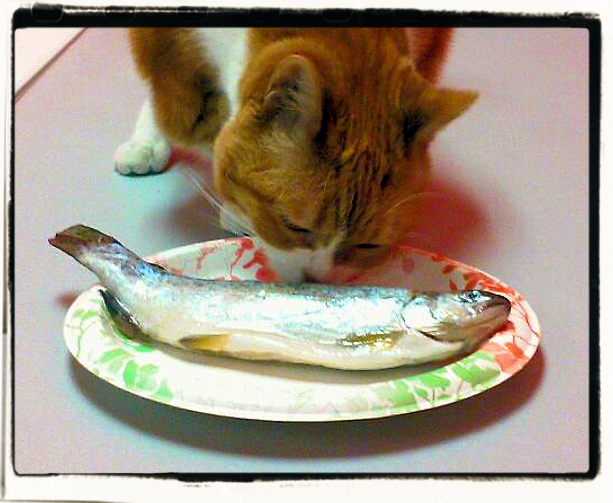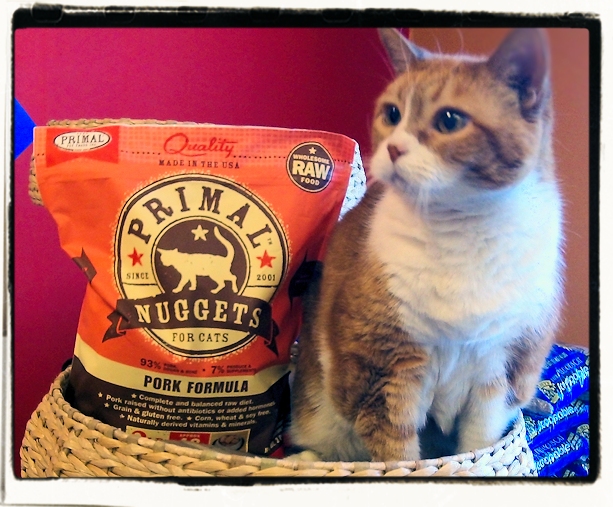Dry kibble. Canned food. Pouched food. Raw food. Freeze-dried food. Air-dried food. Dehydrated food. So many food options are now available for your kitty, but which are best?
Before considering the form of food you should feed your feline, it’s important to consider the content of food you should be feeding. Cats are obligate carnivores, which means they require a meat-based diet in order to obtain all the nutrients their bodies need for optimal health. In the wild, a cat’s natural diet would consist of rodents, birds, insects, and lizards – a raw diet that’s high in moisture, high in protein, moderate in fat, and low in carbohydrates.

Modern housecats are descended from small African wildcats that originated in the Middle Eastern desert, and as such they don’t have a strong thirst mechanism. There’s rarely water available to drink in the desert, so what’s the point of getting thirsty? Just like their desert-dwelling ancestors, our companion kitties are anatomically and physiologically designed to get their hydration needs met from the foods they consume, whether it’s a juicy, fresh-caught mouse, or the store-bought food we put in their bowl. If a cat doesn’t get sufficient water intake from the food she consumes, she may not make up the difference at the water bowl, and she runs the risk of kidney and bladder problems from chronic subclinical dehydration.
When trying to decide what to feed your cat, it’s obviously best to follow Mother Nature’s model of a meat-based diet that’s high in moisture, low in carbs, and minimally processed. Commercially available frozen raw foods meet these criteria while taking the guesswork and hassle out of preparing nutritionally adequate raw meals yourself. Consisting primarily of raw muscle meat, raw organ meat, and bone, these complete and balanced diets reasonably approximate the wild diet of a carnivorous predator.
A growing number of freeze-dried and dehydrated raw food products are now available that provide the nutritional benefits of frozen raw food without the need to thaw. Simply adding warm water – yes, hydration! – to these shelf-stable foods creates a meal that is tasty, aromatic, and carnivore-friendly. Freeze-dried and dehydrated raw foods are a very convenient way to add minimally processed food to your cat’s diet.

If feeding a raw diet isn’t feasible or appealing, you can meet your kitty’s animal-based protein and moisture needs with high-quality, grain-free wet food in cans and pouches. Most canned and pouched wet foods contain at least 75% moisture, which is crucial for your cat’s kidney and bladder health. Although more processed than raw food, cans and pouches make it very easy to incorporate a wide variety of protein sources (poultry, fish, red meat) into your cat’s diet. In the wild, a cat would not be eating the same ol’ thing day in and day out. A varied diet provides a broader array of nutrients, lessens the chance of food allergies or intolerances developing, and helps prevent finicky eating.
And then there’s kibble…. Dry cat food is undoubtedly a convenient and economical choice for us humans, but it’s not necessarily the best choice for cats from a health and nutrition perspective. Kibble is high in carbohydrates, low in moisture, relatively low in protein and fat, and highly processed – the exact opposite of the natural diet a cat thrives on. Dry food is generally only about 10% moisture, so not only does it not provide much-needed hydration to your cat, it actually pulls water out of your cat’s system in order to be rehydrated for digestion. Lack of proper hydration makes it harder for your cat’s kidneys to function, and also increases the likelihood of bladder stones, crystals, and blockages forming.
Additionally, even the highest-protein kibble contains far more carbohydrates than a cat was ever meant to consume, which can lead to obesity, diabetes, pancreatitis, and even cancer. Despite the persistent myth that dry food cleans teeth, it actually contributes to poor dental health by leaving a carb-laden film on the teeth that harmful mouth bacteria feast on.
If you must include dry food in your cat’s diet, try to limit it to no more than 50% of meals. Look for grain-free, high-protein foods with responsibly sourced ingredients. Alternatively, air-dried foods offer the convenience of kibble but with higher meat content and much fewer carbs. If you are feeding any type of dry food, it is especially important to keep plenty of fresh water sources available around your house to encourage your cat to drink as much as possible to compensate for the moisture content not being provided by the food.

